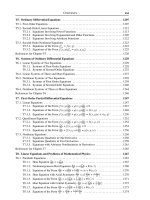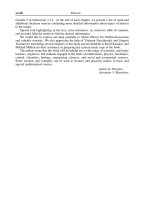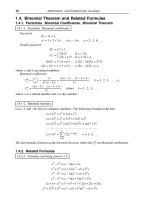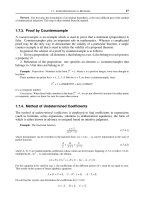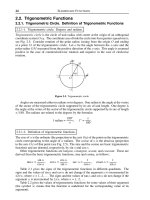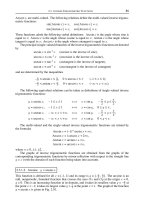Handbook of mathematics for engineers and scienteists part 131 ppsx
Bạn đang xem bản rút gọn của tài liệu. Xem và tải ngay bản đầy đủ của tài liệu tại đây (401.67 KB, 7 trang )
878 DIFFERENCE EQUATIONS AND OTHER FUNCTIONAL EQUATIONS
O
O
O
O
y
y
y
y
ξ
ξ
ξ
ξ
ξ
ξ
ξ
ξ
z
z
z
z
zy=
zy=
z=y
()c
()a
()d
()b
zy=
zfy= ()
zfy= ()
zfy= ()
zfy= ()
-<1 ( )<0ξf
0()1<<fξ
1()< fξ
f () 1ξ < -
Figure 17.2. Iterative sequences y
n+1
= f(y
n
) in a neighborhood of a fixed point ξ = f(ξ). Qualitative analysis
of different cases using the graphs of the function z = f(y).
2
◦
.Letb
2
– 4ac = 0. Then the quadratic equation (17.1.3.2) has one double real root
λ =–
b
2a
,
and the general solution of the difference equation (17.1.3.1) has the form
y
n
= C
1
(1 – n)λ
n
+ C
2
nλ
n–1
.
This formula can be obtained from (17.1.3.3) by taking λ
1
= λ, λ
2
= λ(1 – ε) and passing
to the limit as ε → 0.
3
◦
.Letb
2
– 4ac < 0. Then the quadratic equation (17.1.3.2) has two complex conjugate
roots
λ
1
= ρ(cos ϕ + i sin ϕ), λ
2
= ρ(cos ϕ – i sin ϕ),
ρ =
c
a
,tanϕ =–
1
b
√
4ac – b
2
,
and the general solution of the difference equation (17.1.3.1) has the form
y
n
= C
1
ρ
n
sin[(n – 1)ϕ]
sin ϕ
+ C
2
ρ
n–1
sin(nϕ)
sin ϕ
.
This formula can also be obtained from (17.1.3.3) by expressing λ
1
and λ
2
in terms of ρ
and ϕ.
17.1. DIFFERENCE EQUATIONS OF INTEGER ARGUMENT 879
17.1.3-2. Nonhomogeneous linear equations.
A second-order nonhomogeneous linear difference equation with constant coefficients has
the form
ay
n+2
+ by
n+1
+ cy
n
= f
n
.(17.1.3.4)
The general solution of this equation is given by
y
n
= C
1
λ
1
λ
n
2
– λ
n
1
λ
2
λ
1
– λ
2
+ C
2
λ
n
1
– λ
n
2
λ
1
– λ
2
+ y
n
,
where
y
0
= y
1
= 0, y
n
=
1
a
n–2
k=0
λ
n–k–1
1
– λ
n–k–1
2
λ
1
– λ
2
f
k
,
C
1
and C
2
are arbitrary constants, and λ
1
, λ
2
are the roots of the quadratic equation
(17.1.3.2).
17.1.3-3. Boundary value problem.
The solution of the boundary value problem for equation*
ay
n+1
+ by
n
+ cy
n–1
= f
n
, n = 1, 2, , N – 1,
with the boundary conditions
y
0
= μ
1
, y
N–1
= μ
2
is given by the formula
y
n
=
(λ
1
λ
2
)
n
(λ
N–n
1
– λ
N–n
2
)
λ
N
1
– λ
N
2
μ
1
+
λ
n
1
– λ
n
2
λ
N
1
– λ
N
2
μ
2
–
1
a
n–1
k=1
(λ
1
λ
2
)
n–k
(λ
N–n
1
– λ
N–n
2
)(λ
k
1
– λ
k
2
)
(λ
1
– λ
2
)(λ
N
1
– λ
N
2
)
f
k
–
1
a
N–1
k=n
(λ
N–k
1
– λ
N–k
2
)(λ
n
1
– λ
n
2
)
(λ
1
– λ
2
)(λ
N
1
– λ
N
2
)
f
k
.
17.1.4. Second-Order Linear Difference Equations with Variable
Coefficients
17.1.4-1. Second-order homogeneous linear difference equations. General solution.
1
◦
. A second-order homogeneous linear difference equation with variable coefficients has
the form
a
n
y
n+2
+ b
n
y
n+1
+ c
n
y
n
= 0.(17.1.4.1)
The trivial solution y
n
= 0 is a particular solution of the homogeneous linear equation.
Let y
(1)
n
, y
(2)
n
be particular solutions of equation (17.1.4.1) satisfying the condition
y
(1)
0
y
(2)
1
– y
(2)
0
y
(1)
1
≠ 0.(17.1.4.2)
Then the general solution of equation (17.1.4.1) is given by
y
n
= C
1
y
(1)
n
+ C
2
y
(2)
n
,(17.1.4.3)
where C
1
and C
2
are arbitrary constants.
* This equation is obtained from (17.1.3.4) by shifting the subscript of the sought function by unity.
880 DIFFERENCE EQUATIONS AND OTHER FUNCTIONAL EQUATIONS
Remark. If condition (17.1.4.2) holds, then the solutions y
(1)
n
, y
(2)
n
are linearly independent and for all
n the following inequality holds: Δ
n
= y
(1)
n
y
(2)
n+1
– y
(2)
n
y
(1)
n+1
≠ 0. It is convenient to single out two linearly
independent solutions y
(1)
n
, y
(2)
n
with the help of the initial conditions
y
(1)
0
= 1, y
(1)
1
= 0; y
(2)
0
= 0, y
(2)
1
= 1.
2
◦
.Lety
∗
n
be a nontrivial particular solution of equation (17.1.4.1). Then the replacement
y
n
= y
∗
n
u
n
(17.1.4.4)
yields the equation
a
n
y
∗
n+2
u
n+2
+ b
n
y
∗
n+1
u
n+1
+ c
n
y
∗
n
u
n
= 0.(17.1.4.5)
Taking into account that equation (17.1.4.1) holds for y
∗
n
, and substituting
b
n
y
∗
n+1
=–a
n
y
∗
n+2
– c
n
y
∗
n
into (17.1.4.5), we find, after simple transformations, that
a
n
y
∗
n+2
(u
n+2
– u
n+1
)–c
n
y
∗
n
(u
n+1
– u
n
)=0.
Introducing a new variable by
w
n
= u
n+1
– u
n
,(17.1.4.6)
we come to the homogeneous first-order difference equation
a
n
y
∗
n+2
w
n+1
– c
n
y
∗
n
w
n
= 0.
Solving this equation (see Paragraph 17.1.1-1), one finds a solution of the nonhomogeneous
first-order equation with constant coefficients (17.1.4.6) (see Paragraph 17.1.1-3), and then,
using (17.1.4.4), one finds a solution of the original equation.
17.1.4-2. Second-order nonhomogeneous linear equations. General solution.
1
◦
. A second-order nonhomogeneous linear difference equation with variable coefficients
has the form
a
n
y
n+2
+ b
n
y
n+1
+ c
n
y
n
= f
n
.(17.1.4.7)
The general solution of the nonhomogeneous linear equation (17.1.4.7) can be rep-
resented as a sum of the general solution (17.1.4.3) of the corresponding homogeneous
equation (17.1.4.1) and a particular solution y
n
of the nonhomogeneous equation (17.1.4.7):
y
n
= C
1
y
(1)
n
+ C
2
y
(2)
n
+ y
n
,
where
y
0
= y
1
= 0, y
n
=
n–2
j=0
y
(1)
j+1
y
(2)
n
– y
(1)
n
y
(2)
j+1
y
(1)
j+1
y
(2)
j+2
– y
(1)
j+2
y
(2)
j+1
f
j
a
j
, n = 2, 3,
2
◦
.Lety
∗
n
be a nontrivial particular solution of the homogeneous equation (17.1.4.1). Then
the substitutions (17.1.4.4) and (17.1.4.6) yield a nonhomogeneous first-order difference
equation
a
n
y
∗
n+2
w
n+1
– c
n
y
∗
n
w
n
= f
n
.
With regard to the solution of this equation see Paragraph 17.1.1-2.
3
◦
. Superposition principle. Let y
(1)
n
and y
(2)
n
be solutions of two nonhomogeneous linear
difference equations with the same left-hand sides and different right-hand sides:
a
n
y
n+2
+ b
n
y
n+1
+ c
n
y
n
= f
n
,
a
n
y
n+2
+ b
n
y
n+1
+ c
n
y
n
= g
n
.
Then αy
(1)
n
+ βy
(2)
n
is a solution of the equation
a
n
y
n+2
+ b
n
y
n+1
+ c
n
y
n
= αf
n
+ βg
n
,
where α and β are arbitrary constants.
17.1. DIFFERENCE EQUATIONS OF INTEGER ARGUMENT 881
17.1.5. Linear Difference Equations of Arbitrary Order with Constant
Coefficients
17.1.5-1. Homogeneous linear equations.
An mth-order homogeneous linear difference equation with constant coefficients has the
general form
a
m
y
n+m
+ a
m–1
y
n+m–1
+ ···+ a
1
y
n+1
+ a
0
y
n
= 0.(17.1.5.1)
The general solution of this equation is determined by the roots of the characteristic
equation
a
m
λ
m
+ a
m–1
λ
m–1
+ ···+ a
1
λ + a
0
= 0.(17.1.5.2)
The following cases are possible:
1
◦
. All roots λ
1
, λ
2
, , λ
m
of the characteristic equation (17.1.5.2) are real and distinct.
Then the general solution of the homogeneous linear differential equation (17.1.5.1) has the
form
y
n
= C
1
λ
n
1
+ C
2
λ
n
2
+ ···+ C
m
λ
n
m
,
where C
1
, C
2
, , C
m
are arbitrary constants.
2
◦
.Therearek equal real roots λ
1
= λ
2
= ···= λ
k
(k ≤ m), and the other roots are real
and distinct. In this case, the general solution is given by
y
n
=(C
1
+ C
2
n + ···+ C
k
n
k–1
)λ
n
1
+ C
k+1
λ
n
k+1
+ ···+ C
m
λ
n
m
.
3
◦
.Therearek pairs of distinct complex conjugate roots λ
j
= ρ
j
(cos ϕ
j
i sin ϕ
j
)
(j = 1, , k; 2k ≤ m), and the other roots are real and distinct. In this case, the general
solution is
y
n
= ρ
n
1
[A
1
cos(nϕ
1
)+B
1
sin(nϕ
1
)] + ···+ ρ
n
k
[A
k
cos(nϕ
k
)+B
k
sin(nϕ
k
)]
+ C
2k+1
λ
n
2k+1
+ ···+ C
m
λ
n
m
,
where A
1
, , A
k
, B
1
, , B
k
, C
2k+1
, , C
m
are arbitrary constants.
4
◦
. In the general case, if there are r different roots λ
1
, λ
2
, , λ
r
of multiplicities
k
1
, k
2
, , k
r
, respectively, the left-hand side of the characteristic equation (17.1.5.2) can
be represented as the product
P (λ)=a
m
(λ – λ
1
)
k
1
(λ – λ
2
)
k
2
(λ – λ
r
)
k
r
,
where k
1
+ k
2
+ ···+ k
r
= m. The general solution of the original equation is given by the
formula
y
n
=
r
s=1
(C
s,1
+ C
s,2
n + ···+ C
s,k
s
n
k
s
–1
)λ
n
s
,
where C
s,k
are arbitrary constants.
If the characteristic equation (17.1.5.2) has complex conjugate roots of the form
λ = ρe
iϕ
= ρ(cos ϕ i sin ϕ) , then in the above solution, one should extract the real part
on the basis of the relation λ
n
= ρ
n
e
inϕ
= ρ
n
[cos(nϕ) i sin(nϕ)].
882 DIFFERENCE EQUATIONS AND OTHER FUNCTIONAL EQUATIONS
17.1.5-2. Nonhomogeneous linear equations.
1
◦
.Anmth-order nonhomogeneous linear difference equation with constant coefficients
has the general form
a
m
y
n+m
+ a
m–1
y
n+m–1
+ ···+ a
1
y
n+1
+ a
0
y
n
= f
n
.(17.1.5.3)
The general solution of this equation can be represented as the sum y
n
= Y
n
+y
n
,where
Y
n
is the general solution of the corresponding homogeneous equation (for f
n
≡ 0)andy
n
is any particular solution of the nonhomogeneous equation (17.1.5.3). The general solution
of the corresponding homogeneous equation is constructed with the help of the formulas
from Paragraph 17.1.5-1, and a particular solution of the nonhomogeneous equation for an
arbitrary function f
n
is constructed with the help of the formulas from Paragraph 17.1.6-2.
2
◦
. If the roots λ
1
, λ
2
, , λ
m
of the characteristic equation (17.1.5.2) are mutually dis-
tinct, the particular solution of the nonhomogeneous difference equation (17.1.5.3) has the
form
y
n
=
n
ν=m
f
n–ν
m
k=1
λ
ν–1
k
P
(λ
k
)
,(17.1.5.4)
where P (λ) is the characteristic polynomial [coinciding with the left-hand side of equation
(17.1.5.2)], and the prime indicates its derivative
P
(λ) ≡ a
m
mλ
m–1
+ a
m–1
(m – 1)λ
m–2
+ ···+ 2a
2
λ + a
1
.
In the case of complex conjugate roots, solution (17.1.5.4) should be split into the real
and the imaginary parts.
17.1.6. Linear Difference Equations of Arbitrary Order with Variable
Coefficients
17.1.6-1. Homogeneous linear difference equations.
An mth-order homogeneous linear difference equation with variable coefficients has the
form
a
m
(n)y
n+m
+ a
m–1
(n)y
n+m–1
+ ···+ a
1
(n)y
n+1
+ a
0
(n)y
n
= 0.(17.1.6.1)
Functions u
(1)
n
, u
(2)
n
, , u
(m)
n
are called linearly independent solutions of equation
(17.1.6.1) if
1) they take finite values and satisfy equation (17.1.6.1),
2) the relation
C
1
u
(1)
n
+ C
2
u
(2)
n
+ ···+ C
m
u
(m)
n
= 0,foralln = 1, 2, ,
with constants C
1
, C
2
, , C
m
implies that C
1
= ···= C
m
= 0.
If u
(1)
n
, u
(2)
n
, , u
(m)
n
are linearly independent solutions of equation (17.1.6.1), then the
determinant
Δ
n
=
u
(1)
n
u
(1)
n+1
··· u
(1)
n+m–1
u
(2)
n
u
(2)
n+1
··· u
(2)
n+m–1
··· ··· ··· ···
u
(m)
n
u
(m)
n+1
··· u
(m)
n+m–1
(17.1.6.2)
17.1. DIFFERENCE EQUATIONS OF INTEGER ARGUMENT 883
differs from zero for all admissible n. Conversely, if the determinant (17.1.6.2) for solutions
u
(1)
n
, u
(2)
n
, , u
(m)
n
of equation (17.1.6.1) differs from zero for some n, then the solutions
are linearly independent.
If u
(1)
n
, u
(2)
n
, , u
(m)
n
are linearly independent solutions of equation (17.1.6.1), then the
general solution of this equation has the form
y
n
= C
1
u
(1)
n
+ C
2
u
(2)
n
+ ···+ C
m
u
(m)
n
,(17.1.6.3)
where C
1
, C
2
, , C
m
are arbitrary constants.
A solution is determined by prescribing the initial values of the sought function at m
points.
17.1.6-2. Nonhomogeneous linear difference equations.
1
◦
.Anmth-order nonhomogeneous linear difference equation with variable coefficients
has the form
a
m
(n)y
n+m
+ a
m–1
(n)y
n+m–1
+ ···+ a
1
(n)y
n+1
+ a
0
(n)y
n
= f
n
.(17.1.6.4)
The general solution of this equation can be represented as a sum of the general solution
of the corresponding homogeneous equation (17.1.6.1) and a particular solution y
n
of the
nonhomogeneous equation (17.1.6.4):
y
n
= C
1
u
(1)
n
+ C
2
u
(2)
n
+ ···+ C
m
u
(m)
n
+ y
n
.
A particular solution can be determined by the formula
y
0
= y
1
= ··· = y
m–1
= 0, y
n
=
n–m
j=0
A
m,n,j
B
m,j
f
j
a
m
(j)
, n = m, m + 1, ,
where
A
m,n,j
=
u
(1)
j+1
u
(2)
j+1
··· u
(m)
j+1
··· ··· ··· ···
u
(1)
j+m–1
u
(2)
j+m–1
··· u
(m)
j+m–1
u
(1)
n
u
(2)
n
··· u
(m)
n
, B
m,j
=
u
(1)
j+1
u
(1)
j+2
··· u
(1)
j+m
··· ··· ··· ···
u
(m–1)
j+1
u
(m–1)
j+2
··· u
(m–1)
j+m
u
(m)
j+1
u
(m)
j+2
··· u
(m)
j+m
.
2
◦
. Superposition principle. Let y
(1)
n
and y
(2)
n
be solutions of two nonhomogeneous linear
difference equations with the same left-hand side and different right-hand sides:
a
m
(n)y
n+m
+ a
m–1
(n)y
n+m–1
+ ···+ a
1
(n)y
n+1
+ a
0
(n)y
n
= f
n
,
a
m
(n)y
n+m
+ a
m–1
(n)y
n+m–1
+ ···+ a
1
(n)y
n+1
+ a
0
(n)y
n
= g
n
.
Then αy
(1)
n
+ βy
(2)
n
is a solution of the equation
a
m
(n)y
n+m
+ a
m–1
(n)y
n+m–1
+ ···+ a
1
(n)y
n+1
+ a
0
(n)y
n
= αf
n
+ βg
n
,
where α and β are arbitrary constants.
884 DIFFERENCE EQUATIONS AND OTHER FUNCTIONAL EQUATIONS
17.1.7. Nonlinear Difference Equations of Arbitrary Order
17.1.7-1. Difference equations of mth order. General solution.
Let y
n
= y(n) be a function of integer argument n = 0, 1, 2, An mth-order difference
equation, in the general case, has the form
F (n, y
n
, y
n+1
, , y
n+m
)=0.(17.1.7.1)
A solution of the difference equation (17.1.7.1) is a discrete function y
n
that, being
substituted into the equation, turns it into identity. The general solution of a difference
equation is the set of all its solutions. The general solution of equation (17.1.7.1) depends
on m arbitrary constants C
1
, , C
m
. The general solution can be written in explicit form
as
y
n
= ϕ(n, C
1
, , C
m
), (17.1.7.2)
or in implicit form as Φ(n, y
n
, C
1
, , C
m
)=0. Specifi cvaluesofC
1
, , C
m
define
specific solutions of the equation (particular solutions).
Any constant solution y
n
= ξ of equation (17.1.7.1), where ξ is independent of n,is
called an equilibrium solution.
Remark. The term difference equation was introduced in numerical mathematics in connection with the
investigation of equations of the form
G(n, y
n
, Δy
n
, , Δ
m
y
n
)=0 (17.1.7.3)
with finite differences*
Δy
n
= y
n+1
– y
n
, Δ
2
y
n
= y
n+2
– 2y
n+1
+ y
n
, Δ
m
y
n
= Δ
m–1
Δy
n
.(17.1.7.4)
The replacement of the finite differences in (17.1.7.3), by their explicit expressions in terms of the values of
the sought function according to (17.1.7.4), brings us to equations of the form (17.1.7.1).
17.1.7-2. Construction of a difference equation by a given general solution.
Suppose that the general solution of a difference equation is given in the form (17.1.7.2).
Then the corresponding mth-order difference equation with this solution can be constructed
by eliminating the arbitrary constants C
1
, , C
m
from the relations
y
n
= ϕ(n, C
1
, , C
m
),
y
n+1
= ϕ(n + 1, C
1
, , C
m
),
y
n+m
= ϕ(n + m, C
1
, , C
m
).
17.1.7-3. Cauchy’s problem and its solution. The step method.
A difference equation resolved with respect to the leading term y
n+m
has the form
y
n+m
= f (n, y
n
, y
n+1
, , y
n+m–1
). (17.1.7.5)
The Cauchy problem consists of finding a solution of this equation with given initial values
of y
0
, y
1
, , y
m–1
.
* Finite differences are used for the approximation of derivatives in differential equations.



